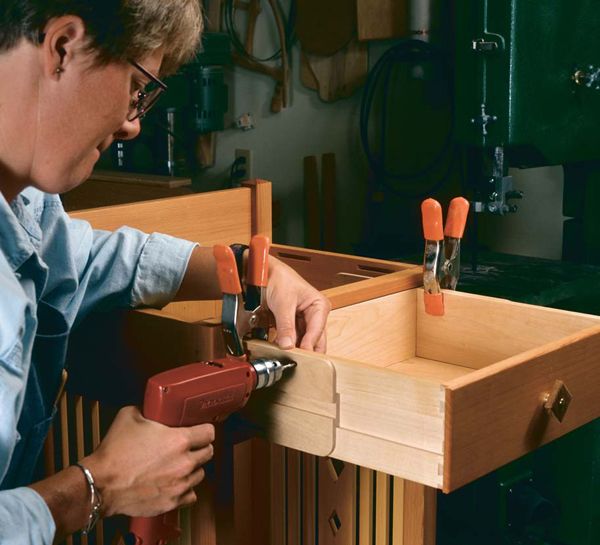All-Wood Extension Drawer Slides
Telescoping dovetails support a fully opened drawer with style
Synopsis: After one too many drawer spills, Karen Robertson set about designing a slide that worked like metal but was good-looking enough to use on fine furniture. She ended up with a telescoping dovetail mechanism that uses an intermediate slider with a dovetail on one face that fits a groove in the drawer side. The other face is grooved to match a dovetailed cleat fastened to the inside of the cabinet. A detailed project plan illustrates her design. She builds the drawer first and then makes the cleats and wood drawer slides, spending time to fine-tune the machine setups and sliding dovetails. Then she installs the stop pins and applies wax to keep the parts moving smoothly. She includes side information on building a jig for plunge-routing the slots.
I was rifling through my desk drawer trying to find a key, when the drawer spilled for the third time that day. As I crawled around collecting paper clips, empty film canisters and pens with no springs, I decided to design a drawer slide that would put an end to this sort of thing. I wanted something that worked like a metal, full-extension drawer slide but was good-looking enough to use on fine furniture.
I played around with several versions and finally settled on a telescoping dovetail mechanism. The key to the system is an intermediate slider with a dovetail on one face that fits a groove in the drawer side. The other face is grooved to match a dovetailed cleat fastened to the inside of the cabinet.
More from FineWoodworking.com: |
Like a metal slide, these slides hold a drawer level and stop it from coming out all the way. But unlike a metal slide, this one is easy to make. It uses simple setups and reduces fussing around to a minimum.
As you begin to open the drawer, the slider remains inside the cabinet. When the drawer is halfway open, a pin engages the slider and pulls it out along with the drawer, and when the drawer and slider reach full extension, another pin stops them. At this point, half the slider remains inside the cabinet, acting as a cantilever to support the drawer in the open position.
Build the drawer first
The telescoping dovetail system works best on small- to medium-sized drawers, like those used in dressers and hallway tables. The dimensions shown in the drawing are suitable for drawers from 12 in. to 16 in. deep and 3 in. to 6 in. tall. I’ve also scaled down the dimensions on the drawing and used the system on small, lightweight drawers, such as the 11⁄2-in. drawers that hold my drafting instruments.
The sliders fit between the drawer and its frame, so the drawers are narrower than the opening in the cabinet by twice the thickness of the sliders. To hide them, I put a 1⁄4-in. lip on each side of the drawer front.
From Fine Woodworking #117
For the full article, download the PDF below:
Fine Woodworking Recommended Products

Jorgensen 6 inch Bar Clamp Set, 4 Pack

Bessey EKH Trigger Clamps

Dubuque Clamp Works Bar Clamps - 4 pack






















Log in or create an account to post a comment.
Sign up Log in